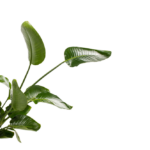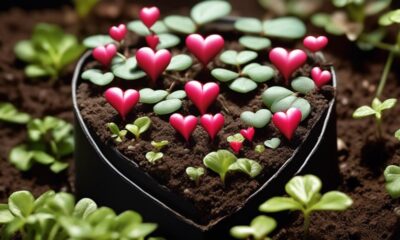Plants
Umbrella Plant Care: A Comprehensive Guide

Have you ever wanted to bring a touch of nature into your indoor or outdoor space with beautiful houseplants? Whether you’re looking for a new plant with green leaves to freshen up your living room or add some life to your garden, there are plenty of options to choose from.
Look no further than the umbrella plant. With its glossy, dark green leaves, the octopus tree is a perfect addition to any indoor garden. This houseplant adds a unique and vibrant aesthetic to any environment, making it a great choice for young plants. Standing tall at up to 6 feet, the dwarf umbrella plant, also known as the umbrella tree, becomes a beautiful plant and striking focal point in your home or garden.
But the benefits of the umbrella plant, a popular houseplant for indoor gardens, go beyond its visual appeal. This versatile indoor garden plant, known as the umbrella tree, is a great addition to any home. It not only adds beauty but also helps purify the air.

With its air-purifying qualities, it improves the overall air quality in our homes. Indoor gardens, like the umbrella tree, have the ability to filter out harmful toxins and release fresh oxygen into the home’s surrounding atmosphere. And with its ability to thrive in various light conditions and tolerate different temperature ranges, the umbrella tree is a low-maintenance addition to our indoor spaces. We need this versatile plant for our homes.
So, whether you need to enhance your living room decor with a tree or create a serene outdoor oasis with a tree, the umbrella plant is an excellent choice. Join us as we explore the characteristics and ideal growing conditions of the umbrella tree. Learn about the specific needs of this unique plant.
Planting Umbrella Plants
There are a few key factors to consider.
Choosing the Right Soil
The type of soil you use plays a crucial role in the health and growth of your umbrella plant. These umbrella tree plants prefer well-draining soil that retains some moisture but doesn’t become waterlogged. It’s important to strike the right balance to ensure optimal conditions for your plant.
A mixture of peat moss, perlite, and potting soil is ideal for providing the right balance of nutrients and drainage. Peat moss helps retain moisture, while perlite aids in drainage by preventing the soil from becoming compacted. Potting soil provides essential nutrients that support healthy growth.

On the other hand, heavy clay soils should be avoided when planting umbrella plants. Clay soils tend to retain too much water, leading to root rot and other issues that can harm your plant’s health. By opting for a well-draining soil mix, you can create an environment that promotes healthy root development and overall growth.
Planting Tips
Now that we have discussed the importance of choosing the right soil let’s move on to some helpful tips for planting your umbrella plant successfully.
-
Selecting a Suitable Pot: When choosing a pot for your umbrella plant, opt for one with drainage holes at the bottom. This allows excess water to escape and prevents waterlogging, which can be detrimental to your plant’s health.
-
Choosing an Appropriate Size: Consider the size of your umbrella plant when selecting a pot. Make sure it has enough room for proper root development as well as accommodating future growth.
-
Preparing Your Plant: Before planting your umbrella plant, gently loosen its roots using your hands or a small tool like a garden fork or trowel. This helps encourage healthy growth and allows the roots to spread out more easily in the new soil.
-
Planting Depth: When placing your umbrella plant in the pot, ensure that it is planted at a depth similar to what it was previously growing in. Avoid planting too deep or too shallow, as this can affect its ability to establish and thrive.
-
Watering After Planting: After planting your umbrella plant, give it a thorough watering to help settle the soil and promote root establishment. Be sure not to overwater, as excessive moisture can lead to root rot.
-
Placement: Umbrella plants thrive in bright but indirect light conditions. Find a suitable location for your plant where it can receive ample light without being exposed to direct sunlight, which can scorch its leaves.
Light Requirements
Providing the right amount of light is crucial for their health and growth.
Indoor Lighting
For indoor umbrella plants, it’s important to place them in a location that offers enough light for their needs. Ideally, you should position your plant near a window where it can receive filtered sunlight. This will provide the plant with the necessary light without exposing it to direct sunlight, which can scorch the leaves.
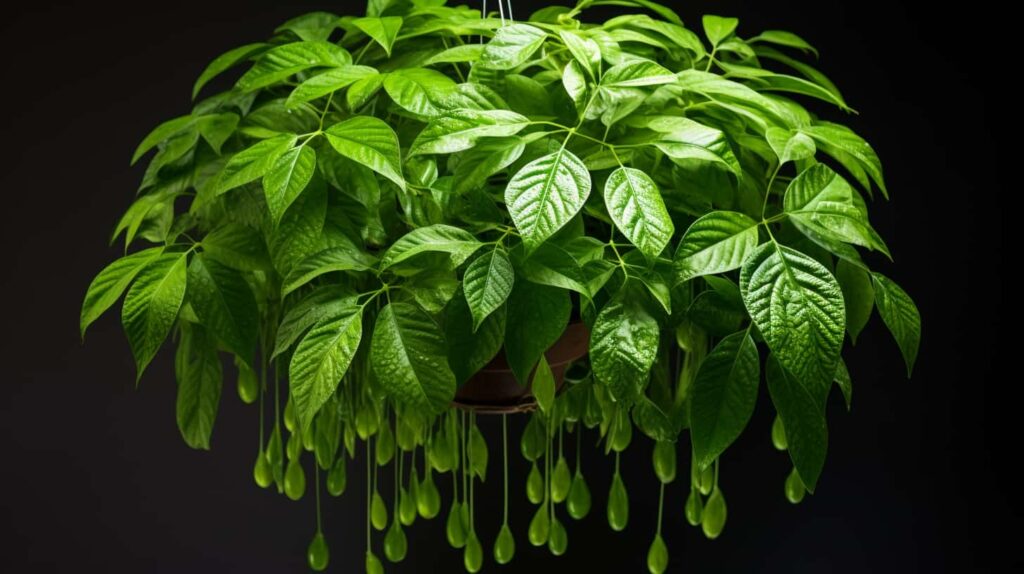
In cases where natural light is limited or not sufficient, you can supplement with artificial lighting. There are various options available, such as fluorescent lights or LED grow lights specifically designed for indoor plants. These lights mimic natural sunlight and provide the necessary spectrum of light for optimal growth.
To ensure even growth on all sides of your umbrella plant, it’s a good idea to rotate it periodically. This will prevent one side from receiving more light than the other, resulting in balanced and healthy foliage.
Outdoor Considerations
If you live in USDA hardiness zones 9 to 11, you have the option to grow your umbrella plant outdoors. However, there are some considerations to keep in mind when choosing an outdoor location for your plant.
Umbrella plants thrive in partial shade rather than direct sunlight. Look for an area that receives dappled sunlight throughout the day or has some protection from intense sunlight. This could be under a tree canopy or near a building that provides shade during certain parts of the day.
During colder months or if frost is expected, it’s important to protect your outdoor umbrella plant by bringing it indoors. Umbrella plants are not frost-tolerant and can suffer damage or die if exposed to freezing temperatures.
Watering Guidelines
Proper watering is essential to keep your umbrella plant healthy and thriving.
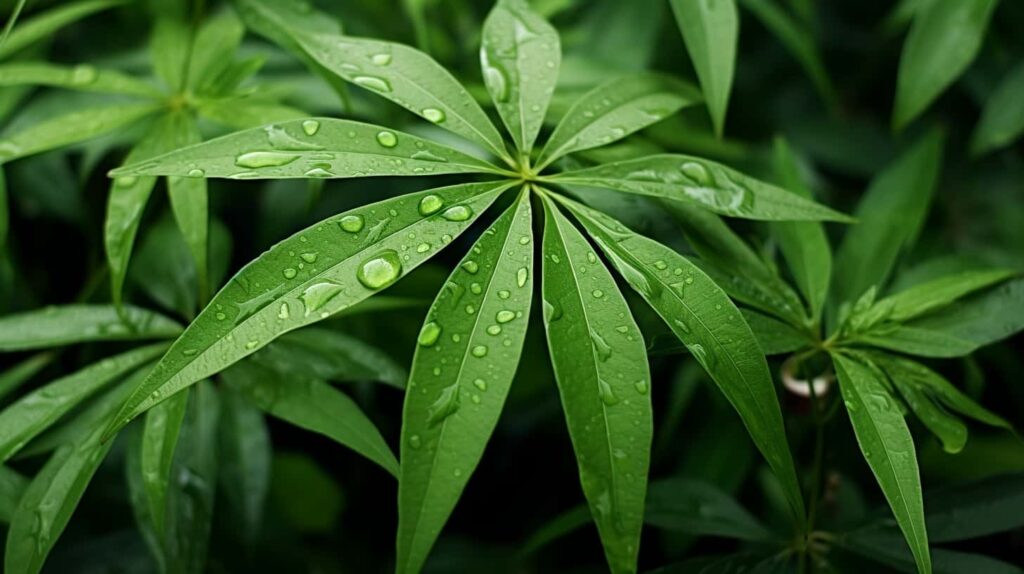
Frequency of Watering
It’s important to find the right balance. You want to provide enough water for the plant’s needs without overdoing it. The general rule of thumb is to water your umbrella plant when the top inch of soil feels dry to the touch. This ensures that the roots have access to moisture without sitting in overly wet conditions.
Overwatering can be detrimental to your umbrella plant’s health and may lead to root rot. To avoid this, make sure that you allow the soil to dry out slightly between waterings. If you’re unsure whether it’s time to water, you can use a moisture meter or simply stick your finger into the soil up to the first knuckle. If it feels moist, hold off on watering for a few more days.
It’s important to note that the frequency of watering may vary depending on factors such as season and environmental conditions. During hot summer months, your umbrella plant may require more frequent watering due to increased evaporation. On the other hand, during cooler winter months when growth slows down, you may need to reduce the frequency of watering.
Signs of Overwatering
Overwatering can have adverse effects on an umbrella plant, so it’s crucial to be able to recognize the signs and take appropriate action. One common sign of overwatering is yellowing or wilting leaves. If you notice that your umbrella plant’s leaves are losing their vibrant green color or appear droopy even though you’ve been regularly watering it, there’s a good chance that excess moisture is causing these symptoms.
Another indicator of overwatering is mushy or rotten roots. When there is too much water in the soil, the roots can become waterlogged and start to decay. To check for this, gently remove your umbrella plant from its pot and inspect the roots. Healthy roots should be firm and white, while overwatered roots will appear mushy or brown.

If you suspect that your umbrella plant is suffering from overwatering, it’s important to take immediate action to prevent further damage. Reduce the frequency of watering and ensure that your plant is not sitting in standing water. Improving drainage by adding drainage holes to the pot or using a well-draining soil mix can also help prevent overwatering.
Fertilizing Schefflera Plants
Fertilizing your umbrella plant, also known as the Schefflera plant, is an essential part of its care routine. By providing the right nutrients at the right time, you can promote healthy growth and vibrant foliage.
Suitable Fertilizers
It is important to choose a balanced liquid fertilizer diluted to half strength during the growing season. This type of fertilizer contains equal amounts of nitrogen (N), phosphorus (P), and potassium (K), which are essential for overall plant health.
To apply the fertilizer, mix it with water according to the instructions on the packaging. It’s crucial not to use full-strength fertilizer as it can overwhelm the plant’s delicate root system. Diluting it by half ensures that your umbrella plant receives just the right amount of nutrients without risking nutrient burn or damage.
During the growing season, which typically occurs in spring and summer, apply fertilizer every two weeks. This frequent application helps provide a continuous supply of nutrients for optimal growth. However, remember that moderation is key—overfertilizing can be detrimental to your umbrella plant’s health.

Seasonal Schedule
Just like any other living organism, plants have different needs throughout the year. Adjusting your care routine according to these changing seasons is crucial for keeping your umbrella plant thriving.
During spring and summer—the active growing period for most plants—it’s important to increase watering and fertilization for your umbrella plant. The warmer temperatures and longer days stimulate growth, making this an ideal time for promoting healthy foliage development. Be sure to monitor soil moisture levels regularly and adjust watering accordingly.
As fall approaches and winter follows suit, growth slows down significantly for many plants, including the umbrella plant. During these cooler months, reduce watering and fertilize less frequently. This allows the plant to enter a dormant phase and conserve energy. However, continue to monitor the soil moisture levels to ensure it doesn’t dry out completely.
Remember that individual plants may have unique needs, so it’s essential to observe your umbrella plant closely and adjust care accordingly. Factors such as humidity levels, temperature fluctuations, and light exposure can all influence its growth patterns.
Temperature and Humidity Control
Maintaining the right temperature and humidity levels is crucial for the health and growth of your umbrella plant. Let’s take a closer look at how to provide the ideal conditions for this beautiful houseplant.
Ideal Temperature Range
Umbrella plants thrive in temperatures between 60°F and 75°F. This range provides the perfect balance for their growth and overall well-being. While they can tolerate slightly cooler temperatures, it’s important to avoid exposing them to frost or extreme heat.
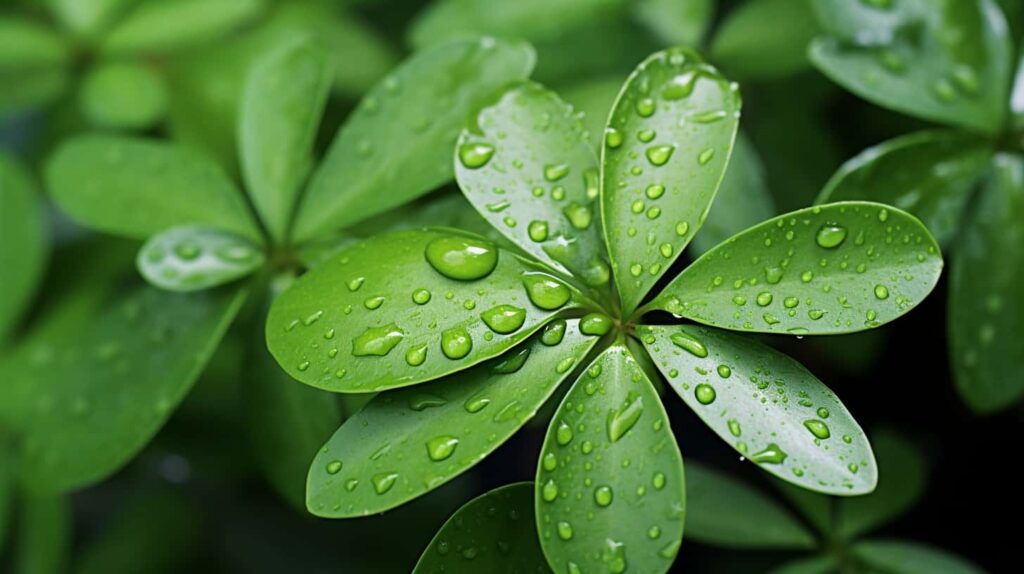
If the temperature drops below 55°F, your umbrella plant may suffer damage, especially if it happens consistently or for an extended period. Similarly, exposing them to temperatures above 90°F can cause stress and harm their leaves.
To create a comfortable environment for your umbrella plant, keep it away from drafty areas such as doors or windows. Sudden temperature fluctuations can shock the plant and lead to leaf drop or stunted growth.
Maintaining Humidity Levels
Umbrella plants naturally grow in tropical rainforests where humidity levels are high. Therefore, replicating these conditions is essential for their well-being indoors.
Increasing humidity around your umbrella plant can be achieved through a few simple methods:
-
Misting: Regularly misting the leaves with water helps raise humidity levels around the plant. Use a spray bottle filled with room-temperature water and gently mist the foliage without soaking it.
-
Water Tray: Placing a tray filled with water near your umbrella plant allows evaporation to increase humidity in its immediate vicinity. As the water slowly evaporates, it creates a more humid microclimate around the plant.
-
Humidifier: If you have multiple indoor plants that require higher humidity levels or live in an area with naturally dry air, using a humidifier is an effective solution. A humidifier releases moisture into the air, helping maintain optimal humidity for your umbrella plant and other houseplants.
On the other hand, it’s important to avoid placing your umbrella plant near heating vents or air-conditioning units. These can dry out the air and reduce humidity levels, which may negatively impact your plant’s health.
Pruning and Maintenance
Pruning and maintenance are essential for keeping your umbrella plant healthy and vibrant. By following proper pruning techniques and establishing a regular cleaning routine, you can ensure that your plant thrives for years to come.

Pruning Techniques
There are a few key techniques to keep in mind. First and foremost, pruning helps maintain the shape of the plant and removes any dead or yellowing leaves that may detract from its overall appearance.
To begin the pruning process, gather clean pruning shears. It’s important to use clean tools to prevent the spread of disease or infection among plants. When making cuts on your umbrella plant, aim to prune just above a leaf node. This will promote optimal regrowth in the area.
Regular pruning also plays a role in controlling the size of your umbrella plant. As these plants can grow quite large if left unchecked, periodic trimming helps maintain a manageable size that fits well within your space.
Cleaning Routine
In addition to pruning, establishing a regular cleaning routine is crucial for the health and longevity of your umbrella plant. Dust can accumulate on the leaves over time, reducing their ability to absorb sunlight and potentially hindering photosynthesis.
To remove dust from your umbrella plant’s leaves, simply wipe them gently with a damp cloth. This will help restore their natural vibrancy and ensure that they can effectively carry out their vital functions.
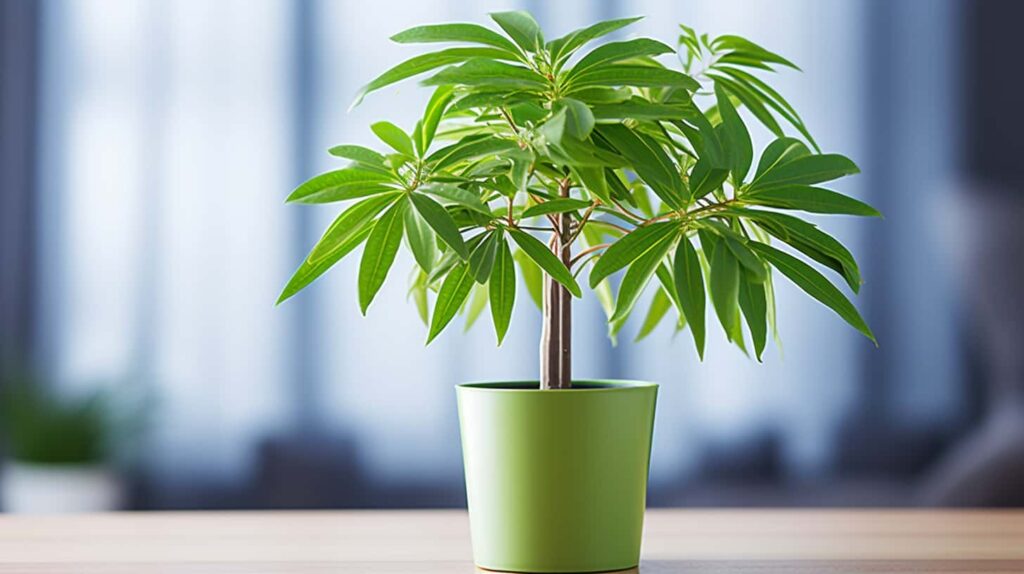
It’s important to note that when cleaning your umbrella plant, you should avoid using any chemical-based cleaners or leaf shine products. These products can be harmful to the foliage and may lead to long-term damage or even death of the plant.
By regularly cleaning your umbrella plant’s leaves, you not only enhance its visual appeal but also help prevent pest infestations. Dust particles often attract pests such as spider mites or mealybugs, which can cause significant damage if left unchecked.
Maintaining a clean and pest-free environment for your umbrella plant is key to its overall health and well-being. By incorporating regular pruning and cleaning into your plant care routine, you can ensure that your umbrella plant remains low maintenance and continues to thrive for years to come.
Propagation Methods
Propagation is an exciting way to expand your collection of umbrella plants. There are various methods you can use, but we will focus on two popular ones: using cuttings and division.
Using Cuttings
One of the easiest ways to propagate an umbrella plant is by taking stem cuttings. This method is best done in the spring or early summer when the plant is actively growing. Here’s how to do it:
-
Select a healthy stem from the parent plant that has at least two sets of leaves.
-
Use clean, sharp scissors or pruning shears to make a clean cut just below a leaf node.
-
Remove any lower leaves from the cutting, leaving only a few at the top.
-
Dip the cut end into rooting hormone powder or gel before planting it in a well-draining potting mix.
-
Make a small hole in the soil with your finger and gently insert the cutting, making sure it stands upright.
-
Firmly press down on the soil around the cutting to ensure good contact between the stem and soil.
-
Water the cutting thoroughly and place it in a warm location with bright indirect light.
-
Maintain high humidity by covering the cutting with a clear plastic bag or using a propagator tray.
Over time, you’ll notice new growth emerging from the tip of your cutting as roots develop beneath the soil surface. Once your new plant has established roots and grown several inches tall, you can transplant it into its permanent pot.
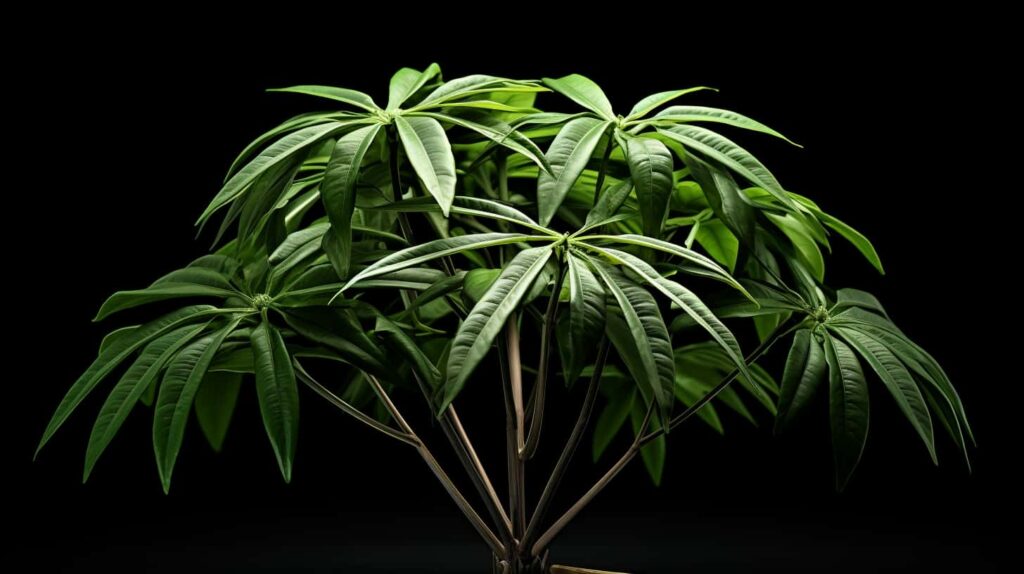
Division
Another propagation method for umbrella plants is division, which involves separating an existing plant into multiple smaller plants. Here’s how to do it:
-
Carefully remove your umbrella plant from its pot and gently shake off excess soil to expose its root system.
-
Inspect the root ball for natural divisions or areas where you can separate individual sections without causing damage.
-
Use clean gardening shears or a sharp knife to cut through the root ball, ensuring that each division has its own set of leaves and roots.
-
Plant each division in a separate pot filled with well-draining potting mix, making sure the roots are covered with soil and the plant stands upright.
-
Water each division thoroughly and place them in a warm location with bright indirect light.
-
Maintain high humidity by covering the newly divided plants with clear plastic bags or using propagator trays.
Division allows you to create multiple new umbrella plants from a single parent plant, making it an efficient way to expand your collection or share plants with friends and family.
Once you’ve successfully propagated your umbrella plant, it’s essential to provide optimal growing conditions for its continued success. Here are some tips to help your plant thrive:
-
Air Circulation: Place your umbrella plant in an area with good air circulation. This will prevent stagnant air around the leaves, reducing the risk of fungal diseases and promoting healthy growth.
-
Humidity: Umbrella plants prefer higher humidity levels. To increase humidity around your plant, place it on a pebble tray filled with water. As the water evaporates, it creates moisture in the air surrounding the plant.
-
Pest and Disease Control: Regularly inspect your umbrella plant for signs of pests such as spider mites or mealybugs. If you notice any infestation, take appropriate action immediately using organic pest control methods or insecticidal soap.
-
Watering: Water your umbrella plant when the top inch of soil feels dry to the touch. Avoid overwatering as this can lead to root rot. Ensure proper drainage by using pots with drainage holes and well-draining potting mix.
Pests and Diseases Management
Dealing with pests and diseases is an essential part of caring for your umbrella plant. By identifying common issues and taking appropriate remedies and prevention measures, you can ensure the health and vitality of your plant.
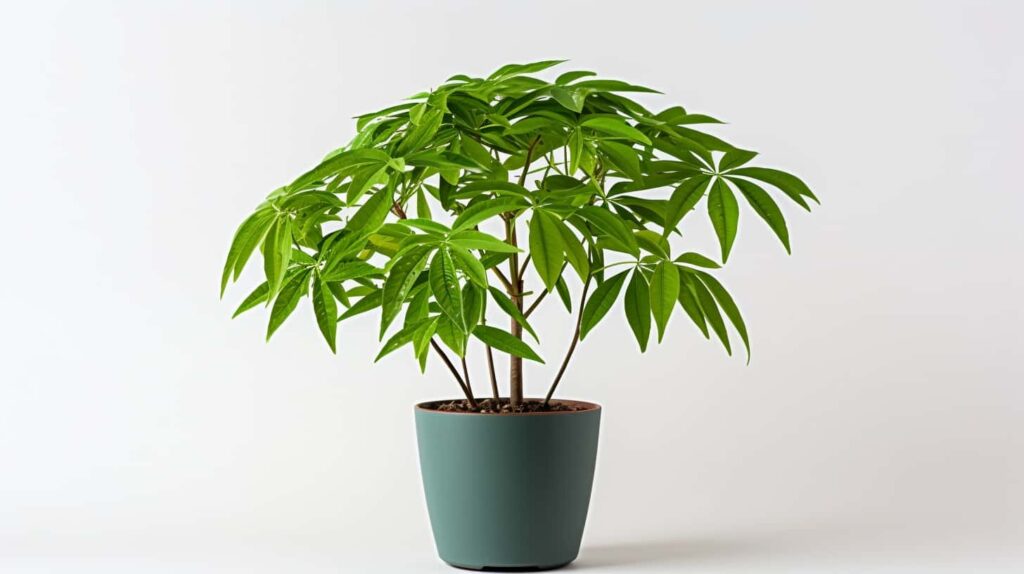
Identifying Common Issues
It’s important to be able to recognize the signs of common problems that can affect your umbrella plant. Yellowing leaves, for example, may indicate overwatering. If you notice this symptom, it’s a good idea to allow the soil to dry out between waterings. This will help prevent root rot and other moisture-related issues.
On the other hand, brown tips on the leaves can be a sign of underwatering or low humidity. To address this problem, make sure you’re providing enough water for your plant’s needs. Increasing humidity levels by misting the plant regularly or using a humidifier can help prevent dryness-related issues.
Drooping leaves are another concern that may arise with your umbrella plant. This symptom can result from both overwatering and underwatering, so it’s important to check the soil moisture level before adjusting your watering frequency. If the soil feels too wet, allow it to dry out before watering again.
Pest infestations are also a potential threat to your umbrella plant’s health. Common pests include spider mites and scale insects, which can cause leaf discoloration and damage if left untreated. Keep an eye out for any signs of these pests on your plant, such as tiny webs or small bumps on the leaves or stems.
Remedies and Prevention
When faced with overwatering issues, one effective remedy is allowing the soil to dry out between waterings. This will give the roots a chance to recover from excess moisture. It may also be necessary to improve drainage by repotting your umbrella plant in a container with adequate drainage holes.
To combat dryness-related problems caused by low humidity, increase the moisture in the air around your plant. Misting the leaves regularly can provide temporary relief, but using a humidifier is a more effective long-term solution. By maintaining optimal humidity levels, you can help prevent issues such as brown tips on the leaves.
It’s essential to take prompt action. Organic insecticidal soap or neem oil can be used to treat spider mites and scale insects. These products are safe for your plant and can effectively control pests when applied according to the instructions on the packaging. Be sure to thoroughly cover all affected areas with the chosen treatment.
Prevention is key. Regularly inspect your umbrella plant for any signs of trouble, such as discoloration or damage. By catching problems early on, you can nip them in the bud before they become more serious.
Special Care for Schefflera Varieties
The Gold Capella is a popular choice among plant enthusiasts. This particular variety features variegated leaves with stunning yellow markings, adding a touch of visual interest to any indoor space. However, despite its unique appearance, the care requirements for Gold Capella are similar to other umbrella plant varieties.
To ensure the health and vitality of your Schefflera Gold Capella, it is essential to follow some general care guidelines. First and foremost, these plants thrive in bright but indirect light. Placing them near a window that receives filtered sunlight is ideal. Direct sunlight can scorch their delicate leaves, so it’s best to avoid exposing them to harsh rays.
Watering your umbrella plant properly is crucial for its overall well-being. While they appreciate consistently moist soil, overwatering can lead to root rot and other issues. It’s important to allow the top inch of soil to dry out before watering again. This will prevent waterlogged roots and promote healthy growth.
Fertilizing your Schefflera Gold Capella every month during the growing season can provide an extra boost of nutrients. Using a balanced houseplant fertilizer diluted according to package instructions will help maintain its vibrant foliage. Be sure not to overfertilize, as this can cause salt buildup in the soil and harm the plant.
In terms of temperature preferences, umbrella plants are relatively adaptable but prefer temperatures between 60°F (15°C) and 75°F (24°C). They can tolerate slightly cooler temperatures but may suffer if exposed to frost or extreme cold conditions.
Humidity levels also play a role in maintaining healthy umbrella plants. These tropical beauties enjoy higher humidity levels but can tolerate average household humidity without issue. To increase humidity around your Gold Capella plant, you can place it on a tray filled with pebbles and water or use a humidifier in the room.
Regular pruning is essential for keeping your umbrella plant looking its best. Scheffleras can grow quite tall, so it’s important to trim them back to maintain their desired height and shape. Pruning also helps remove any dead or yellowing leaves, allowing the plant to focus its energy on new growth.
While umbrella plants are stunning additions to any indoor space, it’s crucial to note that they can be toxic to pets if ingested. The leaves and stems of Schefflera varieties contain calcium oxalate crystals, which can cause irritation and discomfort when consumed by animals.
If you have pets at home, it’s essential to keep your umbrella plant out of their reach. Symptoms of ingestion may include vomiting, drooling, difficulty swallowing, and even more severe reactions in some cases. It’s always better to be safe than sorry.
Consider placing your Schefflera Gold Capella in a location where your pets cannot access it or opt for pet-safe alternatives if you’re concerned about potential toxicity. There are plenty of non-toxic houseplants available that can still bring beauty and greenery into your home without posing a risk to your beloved pets.
Conclusion
In our journey to explore the world of umbrella plants, we have uncovered a wealth of information about their care and maintenance. From planting to pruning, from light requirements to pest management, we now have a comprehensive understanding of how to keep these beautiful plants thriving in our homes.
But our adventure doesn’t end here. Armed with this knowledge, let’s continue to nurture our green companions and create a lush oasis in our living spaces. Let’s experiment with different propagation methods and explore the fascinating world of Schefflera varieties. And most importantly, let’s share our experiences and insights with others, fostering a community of plant enthusiasts who can learn and grow together.
So let’s embark on this botanical journey together, cultivating not only vibrant umbrella plants but also lasting connections among us plant lovers. Happy gardening!
Frequently Asked Questions
Can umbrella plants tolerate low light conditions?
Yes, umbrella plants can tolerate low light conditions to some extent. While they prefer bright, indirect sunlight, they can still survive in areas with lower light levels. Just make sure to avoid placing them in complete darkness as it may lead to weak growth and sparse foliage.
How often should I water my umbrella plant?
Water your umbrella plant when the top inch of soil feels dry to the touch. It’s important not to overwater as this can cause root rot. Allow the soil to partially dry between watering sessions, ensuring proper drainage by emptying any excess water from the saucer or pot.
How do I propagate an umbrella plant?
To propagate an umbrella plant, you can take stem cuttings from a healthy parent plant. Make a clean cut just below a leaf node and remove any lower leaves. Place the cutting in a glass of water or moist soil until roots develop. Once roots have formed, transplant it into a new pot with well-draining soil.
What are common pests that affect umbrella plants?
Umbrella plants are susceptible to pests such as aphids, mealybugs, and spider mites. Regularly inspect your plant for signs of infestation like discolored leaves or webs. If you notice any pests, treat them with insecticidal soap or neem oil spray while ensuring thorough coverage on both sides of the leaves.
How do I care for different varieties of schefflera plants?
Different varieties of schefflera plants may have specific care requirements but generally follow similar guidelines regarding light, watering, and temperature preferences. Research the specific variety you have and adjust care accordingly if needed—for instance, dwarf varieties may require less space compared to larger ones but still benefit from similar care practices.
- About the Author
- Latest Posts
Meet Katherine, the creative enthusiast at ByRetreat who infuses her boundless passion for design into every remote workspace she crafts. With an innate sense of creativity and an eye for unconventional beauty, Katherine brings a unique and inspiring perspective to the team.
Katherine’s love for design is infectious, and her ability to think outside the box sets her apart. She believes that true artistry lies in embracing a variety of styles and mixing them harmoniously to create captivating spaces. By combining different textures, colors, and patterns, Katherine weaves a tapestry of creativity that breathes life into each remote workspace.
Plants
Ideal Hydrangea Spots: Best Place to Plant Hydrangeas
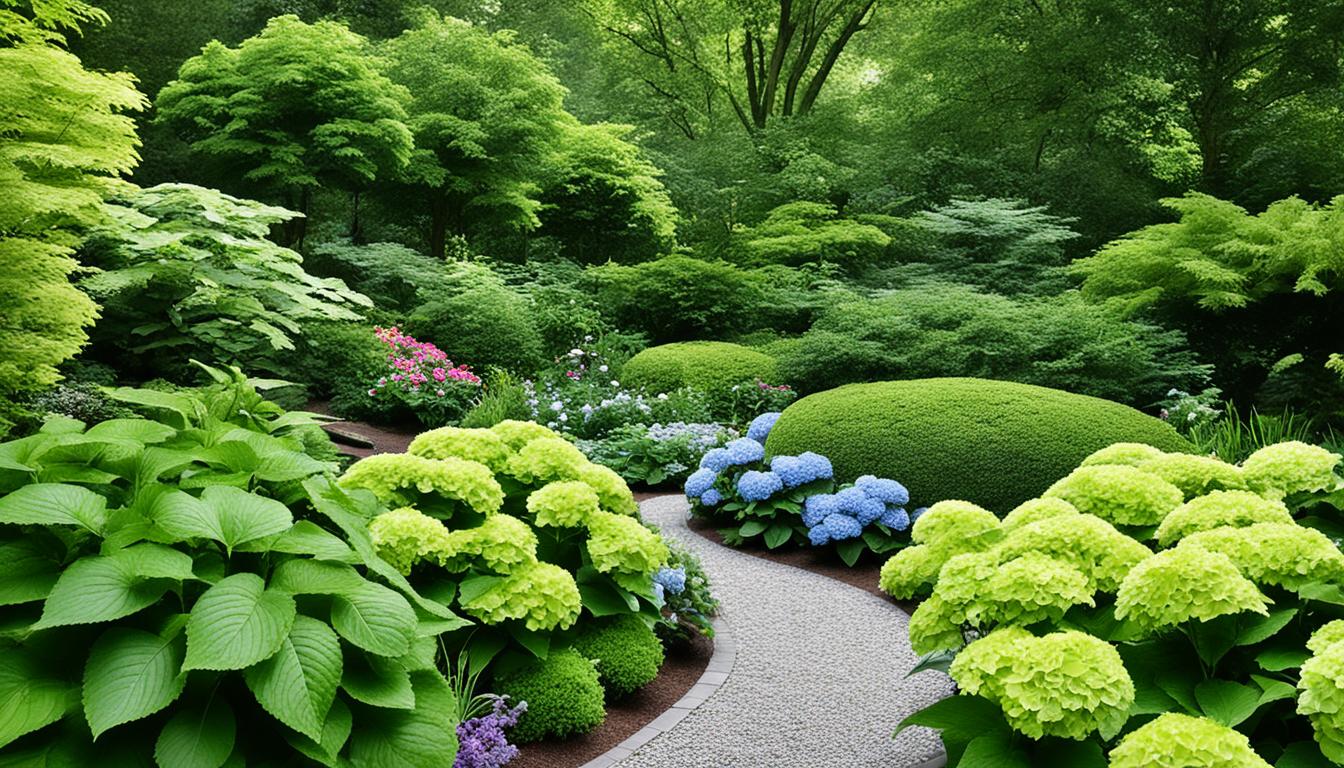
Did you know that the location where you plant your hydrangeas can have a significant impact on their growth and vibrancy? Finding the best place to plant hydrangeas is essential for optimal growth and to ensure that you get the most beautiful blooms.
In this guide, we will explore the different factors to consider when selecting the ideal spot for your hydrangeas. Whether you have a sunny garden or a shady corner, we’ll help you choose the right hydrangea varieties to thrive in various sun and shade conditions. By understanding their sunlight preferences and caring for them properly, you can enjoy vibrant and healthy hydrangea blooms year after year.
Key Takeaways:
- Choosing the right location is crucial for the growth and vibrancy of hydrangeas.
- Hydrangeas can thrive in different sunlight conditions, from full sun to partial shade.
- Consider the specific sunlight needs of different hydrangea varieties for optimal results.
- Proper care, including pruning, fertilizing, and watering, is essential for healthy blooms.
- By following our planting guide and care tips, you can transform your garden with stunning hydrangea displays.
Hydrangeas for Part Shade: Give Us Some Sunblock Please
When it comes to creating the perfect environment for hydrangeas, finding the right balance of sun and shade is key. While some hydrangea varieties thrive in full sun, others prefer a location with partial shade, where they can benefit from the morning sun and enjoy relief from the scorching afternoon rays. These hydrangeas are like beachgoers who know the importance of sunblock, seeking a little shade to protect themselves from the intense heat.
In the family of hydrangeas, there are several popular cultivars that are well-suited for part shade conditions. These varieties have the ability to produce stunning blooms when provided with a combination of filtered light and a few hours of full sun. Among them are the beloved Endless Summer® Hydrangea series, which includes BloomStruck®, Endless Summer®, Blushing Bride®, and Twist-n-Shout®.
Another great choice for morning sun and afternoon shade is the Annabelle Hydrangea, which is known for its spectacular large white flowers. And let’s not forget the many bigleaf hydrangea cultivars that can handle part shade and reward you with their vibrant blossoms.
Here are a few remarkable hydrangea varieties that thrive in part shade:
| Hydrangea Variety | Light Requirements |
|---|---|
| Endless Summer® series (BloomStruck®, Endless Summer®, Blushing Bride®, Twist-n-Shout®) | Morning sun, afternoon shade |
| Annabelle Hydrangea | Morning sun, afternoon shade |
| Bigleaf hydrangea cultivars | Morning sun, afternoon shade |
These hydrangeas have adapted to thrive in part shade by enjoying the gentle morning sun and being sheltered from the intense afternoon heat. This combination of light conditions allows them to produce their enchanting blooms and add a touch of elegance to any garden or landscape.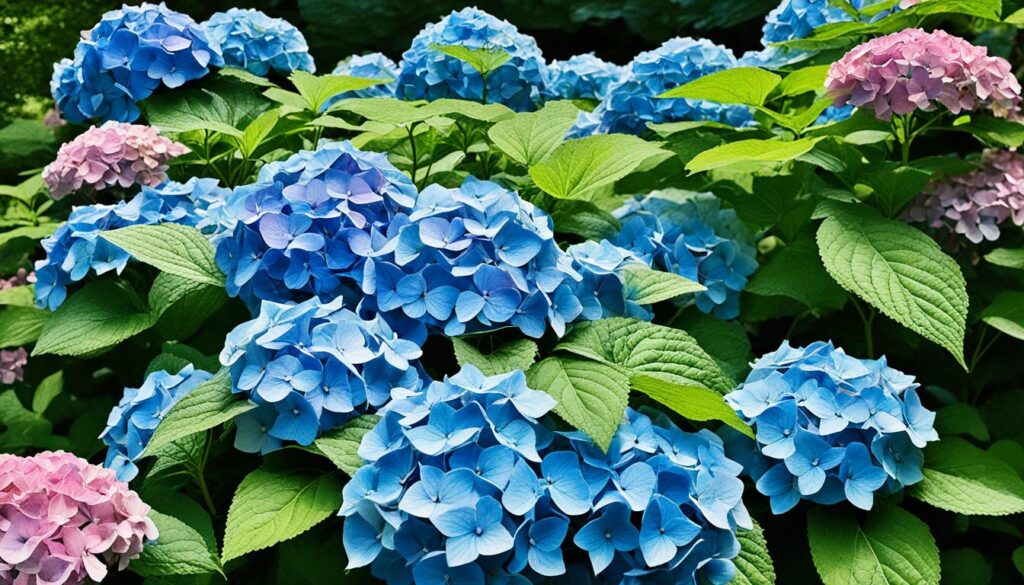
So, if you have a garden or yard with a mix of sunlight and shade, don’t worry! There are plenty of beautiful hydrangeas that will thrive in this environment. Just give them some sunblock (in the form of morning sun) and watch as their blooms light up your space with their breathtaking beauty.
Hydrangeas for Full Sun: We Like It Sunny
While most hydrangeas prefer some shade, there are certain varieties that can thrive in full sun. If your garden gets plenty of sunlight, don’t worry! There are hydrangeas that will flourish in these conditions and reward you with beautiful blooms.
Panicle Hydrangeas
Panicle hydrangeas, known for their cone-shaped flower clusters, are excellent choices for full sun exposure. They can tolerate the direct heat and intense sunlight, making them perfect for sunny spots in your garden. Some popular panicle hydrangeas include:
- Fire Light®
- Limelight
- Pinky Winky®
- Strawberry Sundae®
- Vanilla Strawberry®
Dwarf Varieties
If you have limited space or prefer compact hydrangeas, consider the Let’s Dance® and Cityline® series. These dwarf varieties are perfect for both full sun and part sun environments. They offer the beauty of hydrangeas in a smaller package without compromising on vibrant blooms.
Smooth Hydrangeas
Smooth hydrangeas are another type that can handle full or part sun conditions. These varieties are known for their large rounded flower heads and are a great choice for a sunny garden. Consider the following smooth hydrangeas:
- Incrediball®
- Invincibelle® Ruby
With these hydrangeas, you can enjoy the beauty and charm of these flowering plants even in full sun areas. Just make sure to provide them with proper care and maintenance, including regular watering and occasional fertilization.
Overall, including hydrangeas that thrive in full sun can add a splash of color and vibrancy to your garden. Whether you choose panicle hydrangeas, dwarf varieties, or smooth hydrangeas, these sun-loving beauties will brighten up any sunny corner of your outdoor space.
Growing Hydrangeas in Different Sun and Shade Conditions
When it comes to growing hydrangeas, understanding their sunlight requirements is essential for their success. While many hydrangea varieties thrive in partial shade, oakleaf hydrangeas are known for their adaptability to different sun and shade conditions.
In the northern parts of the United States, oakleaf hydrangeas can tolerate full sun. However, in warmer and southern climates, they prefer some afternoon shade to protect them from excessive heat and sun exposure. This makes them an excellent choice for those looking to plant hydrangeas in regions with varying temperature and sunlight conditions.
What makes oakleaf hydrangeas unique is their ability to also tolerate full shade. This makes them ideal for areas of the garden that receive little to no direct sunlight. Whether it’s a densely shaded corner or underneath taller trees, oakleaf hydrangeas can thrive and add beauty to areas that are typically challenging for other hydrangea varieties.
It’s important to note that while oakleaf hydrangeas are the most adaptable, other hydrangea varieties have specific sunlight needs. When selecting the location for planting, it’s crucial to consider the specific requirements of each hydrangea type to ensure optimal growth and vigor.
By carefully assessing the sunlight conditions in your garden and selecting the appropriate hydrangea varieties, you can create a diverse and captivating display of hydrangeas that thrive in different sun and shade conditions.
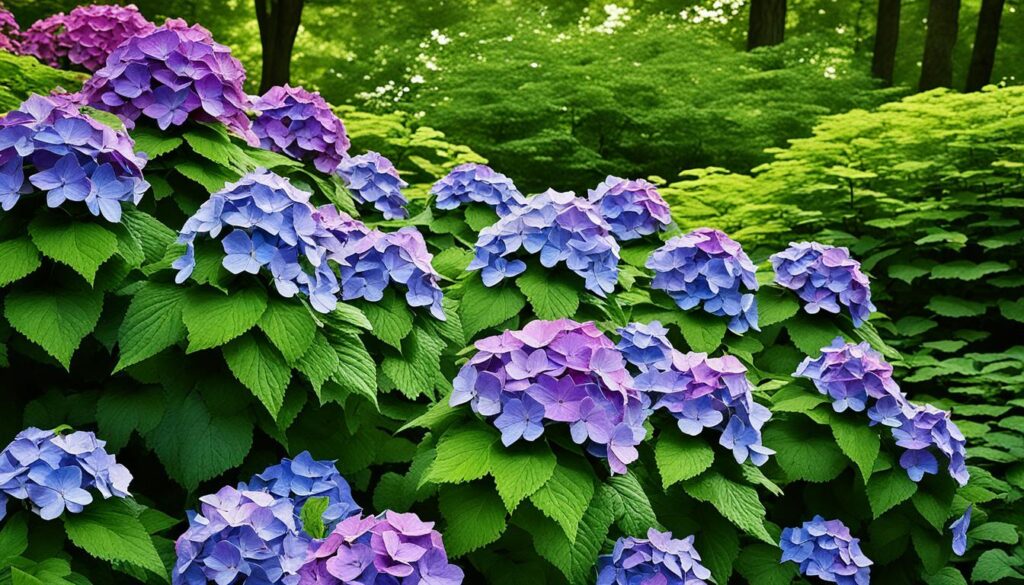
Pruning and Caring for Hydrangeas
Proper pruning and care are essential for the health and vitality of hydrangeas. By implementing appropriate pruning techniques and providing the necessary care, gardeners can ensure the longevity and abundant blooming of their hydrangea plants. Here are some important tips to consider:
Understanding Pruning Methods
When pruning hydrangeas, it’s crucial to understand whether the plant blooms on old wood or new wood. This knowledge will help gardeners avoid accidentally cutting off next season’s flowers.
Tip: Prune hydrangeas that bloom on old wood immediately after flowering. This allows for new growth and development of flower buds for next year. On the other hand, hydrangeas that bloom on new wood can be pruned during late winter or early spring before new growth begins.
Optimal Soil Conditions
Hydrangeas thrive in well-drained soil that is rich in organic matter. A mixture of compost and native soil is ideal for providing the necessary nutrients and moisture retention.
Fertilizing for Healthy Blooms
To promote healthy blooming, it’s recommended to fertilize hydrangeas with a slow-release fertilizer that is high in phosphorus. Phosphorus is essential for promoting flower production and overall plant vitality.
Preventing Leaf Scorch
Hydrangeas are susceptible to leaf scorch, especially during hot and dry periods. To prevent leaf scorch, it’s important to provide hydrangeas with extra water and ensure they have adequate moisture in the soil.

Summary of Pruning and Care Tips
| Pruning Method | Soil Conditions | Fertilizing | Preventing Leaf Scorch |
|---|---|---|---|
| Prune hydrangeas that bloom on old wood immediately after flowering | Well-drained soil with organic compost | Use slow-release fertilizer high in phosphorus | Provide extra water during hot and dry periods |
By following these pruning and care tips, hydrangea enthusiasts can enjoy lush, vibrant blooms year after year. With proper maintenance, these stunning plants will continue to beautify gardens and landscapes.
Conclusion
Planting hydrangeas in the best location and providing proper care and maintenance are key to achieving beautiful and vibrant blooms. By selecting the right spot that balances sun and shade, ensuring well-drained soil, and following recommended pruning and watering practices, gardeners can enjoy the full potential of their hydrangea plants. With the right planting and care, hydrangeas can transform any garden into a colorful and inviting space.FAQ
What is the best place to plant hydrangeas?
What are the best types of hydrangeas for morning sun and afternoon shade?
Can hydrangeas grow in full sun?
Which hydrangea varieties are best for full shade?
How should I prune and care for hydrangeas?
Are there any tips for planting and caring for hydrangeas?
- About the Author
- Latest Posts
Meet Katherine, the creative enthusiast at ByRetreat who infuses her boundless passion for design into every remote workspace she crafts. With an innate sense of creativity and an eye for unconventional beauty, Katherine brings a unique and inspiring perspective to the team.
Katherine’s love for design is infectious, and her ability to think outside the box sets her apart. She believes that true artistry lies in embracing a variety of styles and mixing them harmoniously to create captivating spaces. By combining different textures, colors, and patterns, Katherine weaves a tapestry of creativity that breathes life into each remote workspace.
Plants
Grow Zucchini Successfully: Best Way & Tips

Did you know that zucchini plants are susceptible to squash vine borers, a pest that can quickly kill the plants by cutting off the flow of water? The impact of these destructive borers can be devastating to your zucchini harvest. However, by following the best practices and tips for growing zucchini, you can ensure successful cultivation and enjoy a bountiful harvest.
Whether you are a seasoned gardener or a novice looking to try your hand at gardening, this article will provide you with valuable insights on the best way to grow zucchini and tips for successful cultivation. From avoiding squash vine borers to proper planting techniques, soil requirements, spacing, and pollination, we will cover everything you need to know to grow zucchini successfully.
Key Takeaways:
- Delay planting zucchini until mid-July or use row covers to prevent squash vine borers
- Start zucchini from seeds or seedlings and choose the right time to plant
- Provide well-draining soil enriched with organic material for optimal growth
- Space zucchini plants at least 3-4 feet apart and consider trellising for better air circulation
- Ensure proper pollination for optimal fruit production and harvest zucchini at any size
Planting and Germination
Zucchini, a popular summer squash variety, can be easily grown from seeds or seedlings. While starting zucchini indoors is an option, direct sowing in the ground is the preferred and most common method of planting zucchini seeds. Here’s a step-by-step guide to planting zucchini seeds and ensuring successful germination:
1. Prepare the Soil
Before starting zucchini indoors or sowing the seeds outside, it’s crucial to have well-prepared soil. Ensure the soil is loose, rich in organic matter, and drains well. Incorporating compost or aged manure can greatly improve the soil’s fertility. Measure the soil temperature and wait until it consistently reaches above 55 degrees Fahrenheit for successful germination.
2. Planting Zucchini Seeds
When the soil is ready, plant the zucchini seeds about an inch deep into the soil. Space the seeds at least 3 feet apart to allow ample room for growth. Lightly mist the top of the soil with water to ensure proper moisture levels for the germination of zucchini. Take care not to overwater the seeds, as it can lead to rotting.
Pro Tip: For those who prefer starting zucchini indoors, plant the seeds in peat pots or biodegradable seed starting trays about 2-3 weeks before the last expected frost. Transplant the seedlings outdoors once the soil temperature is suitable.
3. Germination and Thinning
The germination period of zucchini seeds typically ranges from 5 to 10 days. During this time, it’s important to keep the soil consistently moist but not waterlogged. Once the seedlings reach a height of around 3 inches and develop 2 sets of true leaves, it’s time to thin them out. Starting zucchini indoors often leads to more seedlings, so removing the weaker ones will allow the strongest ones to flourish.
4. Timing is Key
For optimal growth, it’s crucial to plant zucchini at the right time. Zucchini thrives in warm soil, so direct sowing should take place in the second half of May when the risk of frost has passed and the soil has warmed up. This timing ensures that the young seedlings will not succumb to cold temperatures.
“Direct sowing zucchini seeds is the most practical and successful method for home gardeners. The plants quickly establish themselves and produce abundant healthy foliage and fruit.” – Gardening Expert, Jessica Washington
By following these planting zucchini seeds and germination guidelines, you can give your zucchini plants a head start in their growth journey. Whether you choose to start the seeds indoors or directly sow them in the ground, with proper care and attention, you’ll soon be rewarded with healthy zucchini plants ready to produce an abundance of delicious squash.
| Benefits of Direct Sowing Zucchini Seeds | Benefits of Starting Zucchini Indoors |
|---|---|
| 1. Simplifies the planting process | 1. Provides an earlier start to the growing season |
| 2. Minimizes transplant shock | 2. Offers more control over seedling development |
| 3. Allows seeds to germinate and grow in their natural environment | 3. Enables better protection against adverse weather conditions |
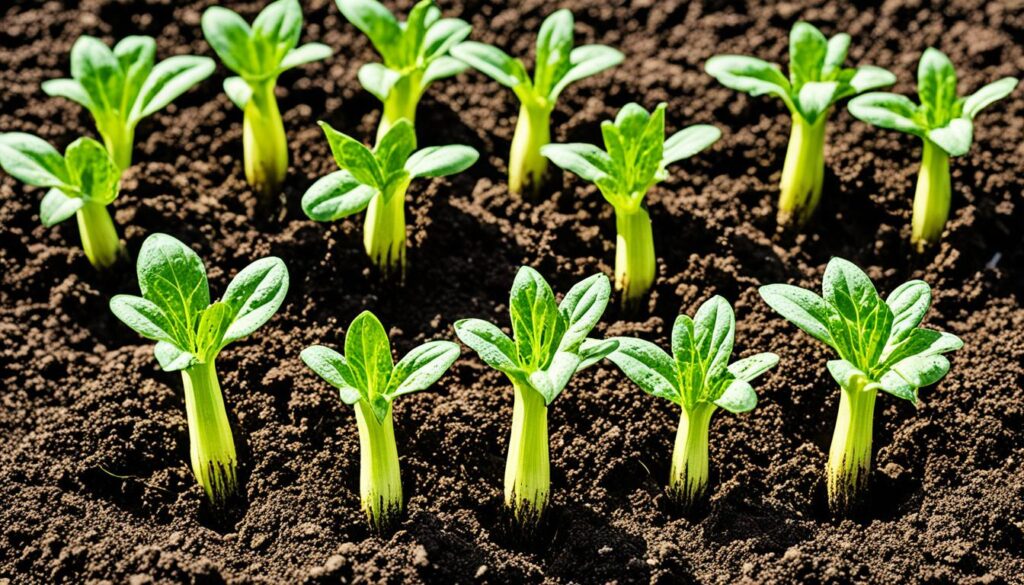
Soil and Location Requirements
Zucchini plants require specific soil and an ideal location to thrive and produce a bountiful harvest. Providing the right conditions for your zucchinis will ensure their health and productivity.
Choosing the Best Soil
Zucchini plants prefer organically rich, fertile, and well-draining soil. When planting in raised beds or containers, it is essential to select a well-draining potting soil. To enhance the soil’s fertility, add organic material or compost at the time of planting. This will help create a nutrient-rich environment for the zucchini plants to thrive.
If you are planting zucchinis directly in the ground, it is crucial to amend the soil with rich organic material or compost. This will improve the soil’s texture and provide the necessary nutrients for the plants to grow strong and healthy. Additionally, good drainage is essential for zucchini plants, as they prefer moist but not waterlogged conditions.
Choosing the Ideal Location
When selecting a location for your zucchini plants, it is important to consider their sunlight requirements. Zucchinis thrive in areas that receive full sun for at least 6-8 hours a day. Choose an area in your garden that is not shaded by buildings or trees, as this can hinder their growth and development.
Furthermore, it is important to note that zucchinis should not be planted in soil where other cucurbits (such as pumpkins or cucumbers) were grown in the past 1-2 years. This practice helps prevent the spread of diseases and pests that may affect the zucchini plants.
By providing the right soil conditions and selecting an ideal location with ample sunlight, you will create an optimal environment for your zucchini plants to flourish and produce an abundant crop.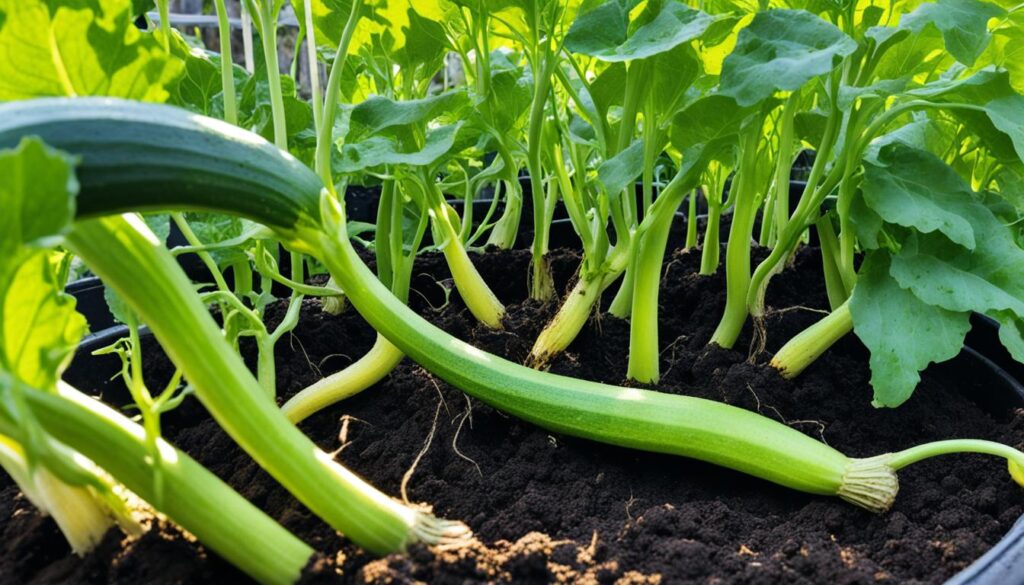
“Zucchini plants prefer organically rich, fertile, and well-draining soil. Provide the right conditions to help your zucchini plants thrive and produce a bountiful harvest.”
Spacing and Trellising
Proper spacing and trellising techniques are essential for the successful growth and development of zucchini plants.
Spacing Zucchini Plants
When it comes to zucchini plant spacing, giving enough room for each plant is crucial for optimal growth. It is recommended to space zucchini plants at least 3-4 feet apart, whether planting them in hills or rows.
For planting in hills, a general guideline is to plant 3 zucchinis per hill in a triangle pattern. Ensure the hills are also spaced 3-4 feet apart to provide enough space for the plants to receive nutrients and expand their root systems.
If growing zucchinis in containers, create a mound in the center of the container and plant three zucchinis around it. This arrangement allows for adequate airflow and efficient use of space while providing the plants with the necessary growing area.
Trellising Zucchini
Another option for maximizing space and aiding in pest management is trellising zucchini plants. By training them to grow vertically along a trellis or stakes, you can create a visually appealing and space-saving garden.
When trellising zucchini, ensure that the trellis or stakes are sturdy enough to support the weight of the plants and their fruit. As the zucchinis grow, gently guide the vines and tendrils toward the trellis, securing them with twist ties or plant clips.
The benefits of trellising zucchini include improved air circulation, which helps prevent disease, easier harvesting, and reduced pest damage since the plants are elevated off the ground.
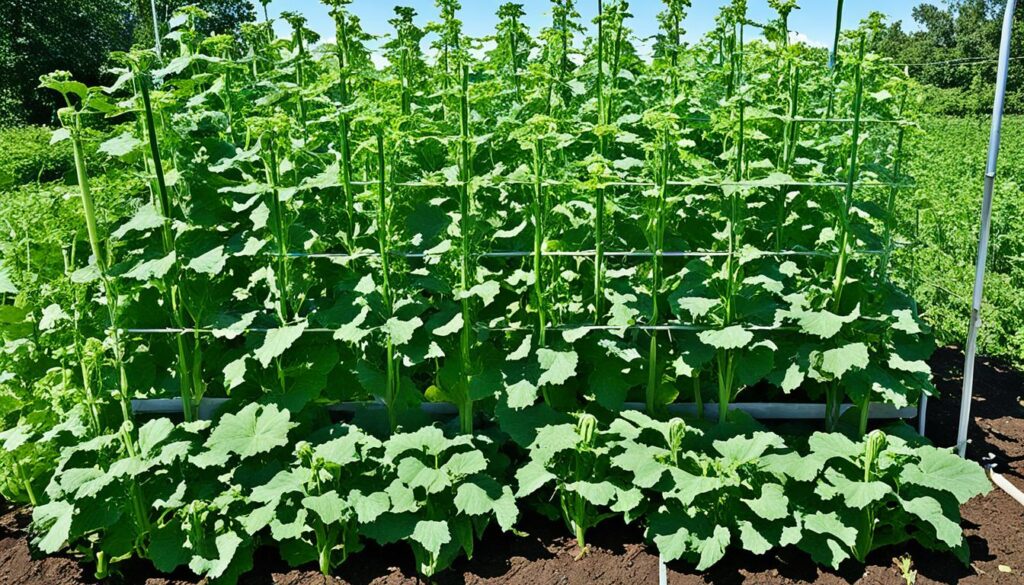
Implementing proper spacing and trellising techniques ultimately promotes healthier zucchini plants, increased productivity, and efficient use of garden space.
Pollination and Fruit Production
Zucchini plants rely on pollination for fruit production. These plants have separate male and female flowers, and the transfer of pollen from the male to the female flowers is crucial for the development of zucchini fruits. To ensure successful pollination, it’s important to understand how pollinators play a role in this process. 
Pollinators such as bees, butterflies, and other insects are attracted to the bright yellow flowers of zucchini plants. To maximize their presence in your garden, consider planting companion flowers like borage, catmint, dill, or dahlias nearby. These flowers will help attract pollinators, increasing the chances of successful pollination.
In some cases, there may be a lack of natural pollination due to factors such as weather conditions or a limited number of pollinators in the area. In such situations, manual pollination can be done to ensure fruit production. This process involves using a small brush or cotton swab to transfer pollen from the male flowers to the female flowers. By gently brushing the inside of the male flower and then transferring the pollen to the stigma of the female flower, you can help facilitate pollination.
Tip: To identify male and female flowers, look for the presence of a small zucchini-shaped swelling at the base of the female flower. Male flowers, on the other hand, do not have this swelling.
Proper pollination is essential for optimal fruit development. It ensures that the female flowers receive the necessary pollen for fertilization, leading to the formation of healthy zucchini fruits. Be sure to monitor the progress of your zucchini plants and check for signs of fruits developing from the female flowers.
When it comes to harvesting zucchini, you can do so at any size. However, larger zucchinis may have more developed seeds and a denser texture, which might not be desirable for certain recipes. In such cases, it is recommended to remove the seeds before consumption. This can be done by slicing the zucchini lengthwise and scooping out the seeds with a spoon.
Conclusion
Successful zucchini cultivation requires attention to several key factors, including avoiding squash vine borers, following proper planting techniques, providing the right soil and location, spacing plants correctly, and ensuring proper pollination. By implementing these tips and techniques, gardeners can enjoy a bountiful harvest of zucchinis that can be incorporated into a wide range of dishes.
The best way to grow zucchini is to start by carefully timing the planting, ensuring that soil temperatures are consistently above 55 degrees Fahrenheit. This warm soil temperature provides an ideal environment for germination and growth. Additionally, choosing a well-lit area with full sun for at least 6 hours a day will help zucchinis thrive.
When it comes to soil and location requirements, zucchini plants prefer organically rich and well-draining soil. Amend the soil with compost or rich organic material to promote healthy growth. Adequate spacing is essential for proper plant development, with a recommended distance of 3-4 feet between plants. Trellising zucchini plants can also save space and improve airflow.
Finally, ensuring proper pollination is crucial for maximizing fruit production. Planting companion flowers near zucchinis can attract beneficial pollinators, and manual pollination can be done to supplement natural pollination. Harvesting can be done at any size, but larger zucchinis may require seed removal before consumption.FAQ
When is the best time to plant zucchini?
How can I prevent squash vine borers from killing my zucchini plants?
What type of soil do zucchini plants prefer?
How should I space my zucchini plants?
Do zucchini plants require manual pollination?
Can I grow zucchini vertically?
- About the Author
- Latest Posts
Meet Katherine, the creative enthusiast at ByRetreat who infuses her boundless passion for design into every remote workspace she crafts. With an innate sense of creativity and an eye for unconventional beauty, Katherine brings a unique and inspiring perspective to the team.
Katherine’s love for design is infectious, and her ability to think outside the box sets her apart. She believes that true artistry lies in embracing a variety of styles and mixing them harmoniously to create captivating spaces. By combining different textures, colors, and patterns, Katherine weaves a tapestry of creativity that breathes life into each remote workspace.
Plants
Best Conditions for Ginger Root Growth Explained
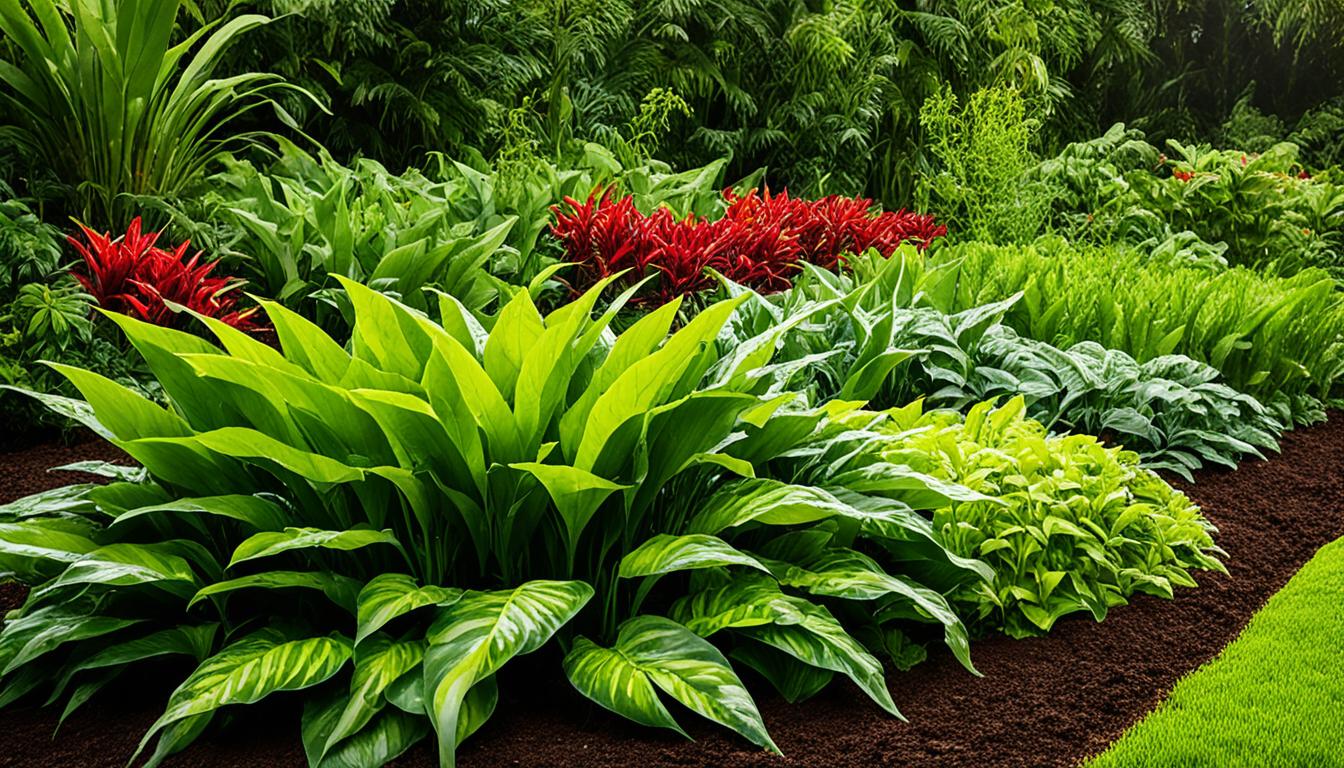
Ginger, known for its unique flavor and medicinal properties, is a versatile root used in everything from cooking to herbal remedies. But did you know that the success of ginger cultivation depends heavily on the conditions in which it is grown? Creating the best conditions for ginger root growth is essential to yield a bountiful harvest and vibrant plants.
From temperature to soil quality and moisture levels, each aspect plays a crucial role in ginger’s growth and well-being. By understanding the optimal conditions, gardeners and enthusiasts can replicate ginger’s tropical habitat and cultivate healthy plants with exceptional flavor and aroma.
In this article, we will explore the optimal conditions necessary for ginger root growth, offering insights and techniques to help you grow ginger successfully. Whether you’re an experienced gardener or a beginner with a green thumb, this guide will provide valuable knowledge to enhance your ginger cultivation.
Key Takeaways:
- Ginger root growth requires specific conditions to thrive.
- Temperature, soil quality, moisture, and shade are essential factors.
- Best practices include using organic matter, maintaining proper drainage, and providing dappled shade.
- Ginger can be grown in containers, hoop houses, or greenhouses.
- Pre-sprouting ginger indoors can maximize the growing season.
Optimal Soil Conditions for Ginger Root Growth
Ginger plants require optimal soil conditions to thrive and produce healthy root growth. By providing the right environment, gardeners can ensure that their ginger plants receive the necessary nutrients and support for robust growth. Here are some essential factors to consider when creating optimal soil conditions for ginger root growth:
- Rich in Organic Matter: Ginger prefers soil that is rich in organic matter, which provides essential nutrients and promotes healthy root development. Adding lots of compost to the ground or using a peat and wood bark-based soilless medium mixed with sand in containers can help create a fertile growing medium.
- Organic Fertilizers and Worm Castings: Supplementing the soil with organic fertilizers and worm castings can further enhance the nutrient content, ensuring that ginger plants have access to the necessary elements for their growth. These natural amendments provide a slow-release source of nutrients, promoting long-term plant health.
- Good Drainage: It is crucial to ensure good drainage in the soil to prevent waterlogging, as standing water can negatively affect ginger growth. To improve drainage, incorporating coarse sand or perlite into the soil can help create a well-draining environment for the roots.
- pH Levels: Maintaining the right pH levels is essential for optimal ginger growth. Ginger plants prefer slightly acidic soil, with pH levels between 5.5 and 6.5. Testing the soil’s pH and making appropriate adjustments using organic soil amendments or sulfur can help create the ideal conditions for ginger plants.
By creating soil conditions that are rich in organic matter, well-draining, and with the right pH levels, gardeners can provide the optimal environment for ginger root growth. The next section will explore the ideal temperature range for ginger plants and the impact it has on their growth and development.
Soil Conditions for Ginger Root Growth
| Soil Condition | Description |
|---|---|
| Rich in organic matter | Ginger prefers soil that is rich in organic matter, such as compost or a peat and wood bark-based soilless medium mixed with sand. |
| Organic fertilizers and worm castings | Adding organic fertilizers and worm castings can provide essential nutrients for ginger plants. |
| Good drainage | Ensuring good drainage in the soil is crucial to prevent waterlogging, which can negatively affect ginger growth. |
| pH levels between 5.5 and 6.5 | Maintaining slightly acidic soil with pH levels between 5.5 and 6.5 is ideal for ginger plants. |

Ideal Temperature Range for Ginger Root Growth
Ginger is a tropical plant that thrives in warm temperatures, making the ideal temperature range a crucial factor for its successful growth. The ideal temperature range for ginger root growth is 70° to 90°F (21° to 32°C). This range provides the optimal conditions for ginger plants to thrive and produce healthy rhizomes.
When growing ginger, it is important to consider the nighttime temperatures as well. It is recommended to plant ginger when nighttime temperatures are consistently above 55°F (13°C). Cooler temperatures can slow down the growth of ginger plants or even cause damage to them, hindering their development.
In regions with colder climates, it may be challenging to maintain these ideal temperatures for ginger growth. However, there are ways to overcome this obstacle and still grow ginger successfully. Growing ginger indoors in a controlled environment, such as a greenhouse or conservatory, can provide the necessary warmth for ginger plants to thrive.
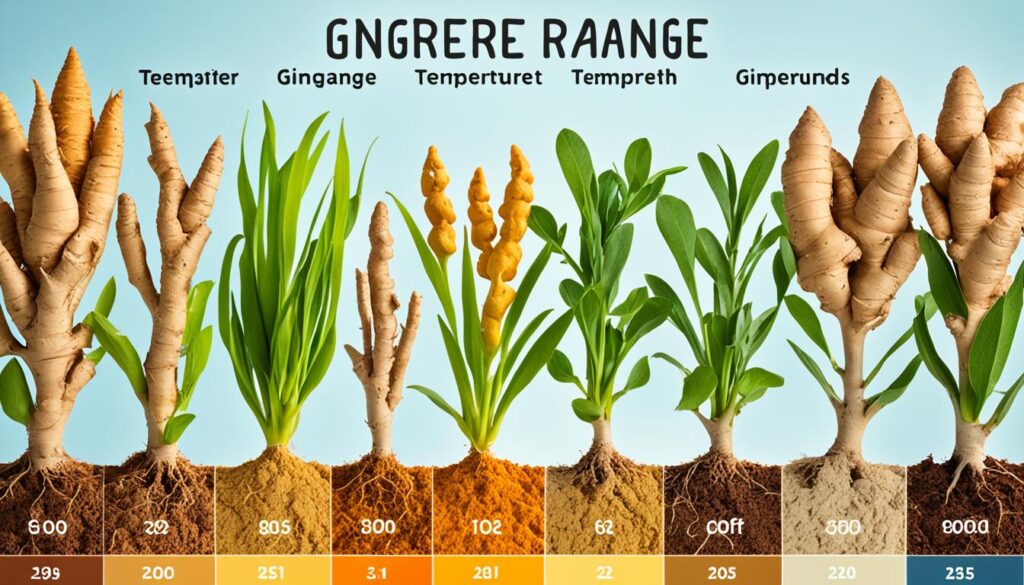
Importance of Moisture for Ginger Root Growth
Ginger is a moisture-loving plant that requires consistent watering to thrive and produce healthy and flavorful roots. Proper moisture management is essential for ginger root growth.
The soil should be kept evenly moist, providing enough water to meet the plant’s needs without overwatering or allowing the soil to dry out completely. Overwatering can lead to waterlogged conditions, which can suffocate the roots and promote the development of root rot. Conversely, letting the soil dry out completely can cause stress to the plant and hinder its growth.
Watering frequency may vary depending on factors such as the climate, humidity levels, and container size. In general, it is advisable to water ginger plants whenever the top inch of soil feels slightly dry. This allows for proper hydration without risking waterlogging.
Proper irrigation techniques and good drainage are crucial for maintaining the ideal moisture levels for ginger root growth. In containers, ensure that there are drainage holes to prevent water from pooling at the bottom. For in-ground planting, selecting a well-draining soil or amending the soil with organic matter can improve moisture balance.
Expert Tip:
When watering ginger plants, it’s important to give them a deep soak, allowing the water to penetrate the root zone. However, avoid overhead watering as it can lead to the development of fungal diseases. Instead, direct the water towards the base of the plant or use a drip irrigation system to ensure precise watering.
By maintaining the right moisture levels through proper watering techniques and good drainage, gardeners can provide the optimal conditions for ginger root growth, ensuring healthy plants and a bountiful harvest.

Moisture Guidelines for Ginger Root Growth
| Moisture Level | Signs | Recommended Action |
|---|---|---|
| Soggy or Waterlogged | Wilting, yellowing leaves; foul odor; root rot | Improve drainage by adding organic matter; reduce watering frequency |
| Too Dry | Wilting, dry soil; slow growth | Increase watering frequency; mulch around plants to retain moisture |
| Evenly Moist | Healthy foliage; steady growth | Continue regular watering; monitor moisture levels |
Benefits of Dappled Shade for Ginger Root Growth
Ginger plants thrive in dappled shade, which provides them with a balanced environment for optimal growth. The benefits of dappled shade include protection from direct sunlight, prevention of soil overheating and excessive drying, and maintenance of suitable moisture levels.
Planting ginger under the shelter of taller crops or using shade cloth can create the perfect conditions for ginger root growth. The dappled shade allows the plants to receive filtered sunlight, which is essential for photosynthesis while reducing the risk of sunburn or heat stress.
“Dappled shade is like a natural sunscreen for ginger plants, shielding them from the harsh rays of the sun and maintaining a cool, comfortable environment.”
By providing dappled shade, you can create an ideal microclimate for ginger root growth. The shade helps regulate soil temperatures, preventing it from becoming too hot and drying out too quickly. This is particularly important for ginger, as it prefers consistently moist soil.
Moreover, dappled shade helps to reduce water evaporation, allowing the roots to stay moist for longer periods. This helps the ginger plants establish a strong root system and absorb essential nutrients from the soil, promoting healthy growth and development.
When setting up dappled shade for your ginger plants, it is important to strike a balance. While providing shade, ensure that there is still enough light penetration for proper photosynthesis. Ginger plants need adequate sunlight to produce energy for growth, but too much direct sunlight can be detrimental.
Consider planting ginger in an area where it receives morning sun and partial afternoon shade. This allows the plants to benefit from the warmth and light of the morning sun while being shielded from the intense heat of the afternoon sun.
To summarize, dappled shade provides numerous benefits for ginger root growth, including protection from direct sunlight, prevention of soil overheating and excessive drying, and maintenance of suitable moisture levels. By implementing dappled shade techniques, you can create an ideal environment for ginger plants to thrive and produce a bountiful harvest.
Pros and Cons of Dappled Shade for Ginger Root Growth
| Benefits of Dappled Shade | Considerations for Dappled Shade |
|---|---|
| Protection from direct sunlight | Ensure there is still enough light for photosynthesis |
| Prevents soil overheating | Find a balance between shade and sunlight |
| Reduces soil drying out | Choose an area with morning sun and partial afternoon shade |
| Maintains suitable moisture levels |

Recommended Planting Techniques for Ginger Root Growth
When it comes to cultivating ginger, selecting the right planting technique is crucial for successful root growth. Whether using whole rhizomes or cut pieces, understanding the proper methods will optimize your ginger harvest. Here are some recommended planting techniques:
1. Using Whole Rhizomes
Planting ginger with whole rhizomes is a straightforward technique that yields excellent results. Look for healthy, plump rhizomes with well-developed buds or eyes. These larger rhizomes tend to grow quicker and produce more robust plants.
To plant whole rhizomes:
- Prepare the soil by loosening it with a garden fork or tiller.
- Dig a trench that is about 6 to 8 inches deep.
- Place the rhizomes in the trench with the eyes facing upwards.
- Cover the rhizomes with soil, ensuring they are well-buried but not too deep.
- Water gently to settle the soil.
2. Using Cut Rhizome Pieces
If you have limited planting material or want to maximize your ginger yield, using cut rhizome pieces is a viable option. When cutting the rhizomes, ensure each piece has at least one bud or eye.
To plant cut rhizome pieces:
- Prepare the soil or select a suitable container with good drainage.
- Fill the container with a well-draining potting mix or amend the soil with organic matter.
- Place the cut rhizome pieces in the soil or container, burying them about 1 to 2 inches deep.
- Water thoroughly to encourage root establishment.
Note: Make sure there is adequate room for the rhizomes to grow when planting in containers. This will prevent overcrowding and promote healthier plant development.
3. Pre-sprouting Indoors
For gardeners who wish to extend the growing season or gain a head start on ginger production, pre-sprouting indoors is an effective technique. This method involves placing the rhizomes in a tray with moist compost or paper towel to encourage early sprouting.
To pre-sprout ginger indoors:
- Select healthy rhizomes with visible eyes.
- Fill a tray with moist compost or lay paper towels on a flat surface.
- Place the rhizomes on the compost or paper towels, positioning them with the eyes facing upwards.
- Maintain the moisture level by misting regularly.
- Keep the tray or paper towels in a warm location with indirect sunlight.
- Once sprouts have developed, carefully transplant them into individual containers or directly into the ground.
Pre-sprouting allows for an earlier harvest and ensures that the ginger plants have a strong start before being exposed to outdoor conditions.
Remember, ginger responds well to a warm and humid environment, so providing the optimal conditions during the planting process will contribute to its overall growth and development.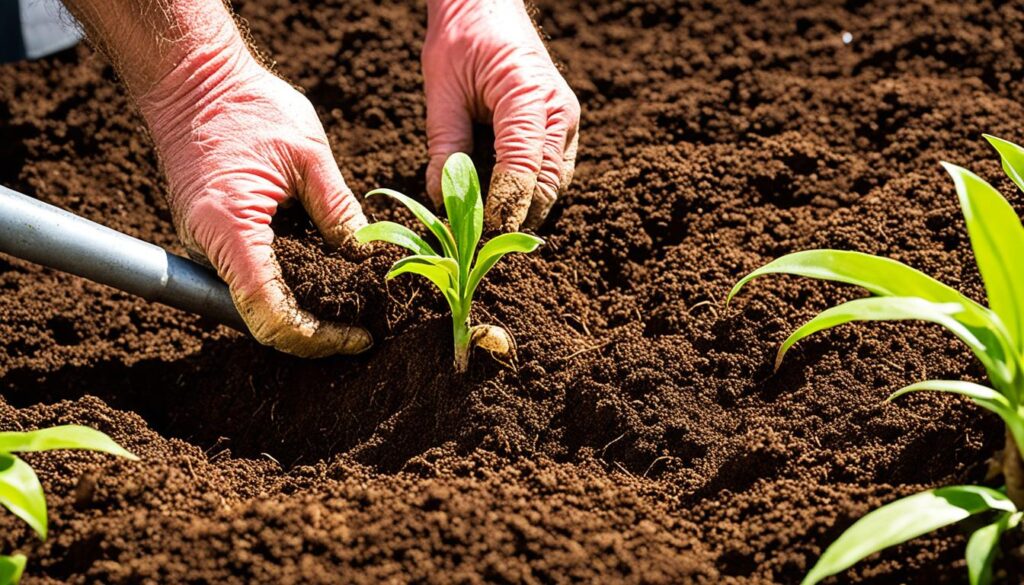
| Planting Technique | Advantages | Disadvantages |
|---|---|---|
| Using Whole Rhizomes | – Quicker growth – Larger harvests |
– Requires more planting material – Limited control over spacing |
| Using Cut Rhizome Pieces | – Maximizes planting material – Allows for precise spacing |
– Slower initial growth – Smaller rhizome yields |
| Pre-sprouting Indoors | – Provides an early start – Enhances germination rates |
– Requires additional indoor space – Requires regular misting |
Care Tips for Ginger Root Growth
Proper care is crucial for the successful growth of ginger roots. By providing the right conditions, you can ensure healthy plants and a bountiful harvest. Here are some essential care tips for ginger root growth:
1. Warmth: Ginger plants thrive in warm environments, so it’s important to provide them with a suitable temperature. During the summer, whether you are growing ginger outdoors or indoors, it’s beneficial to place the plants in a warm and humid area.
2. Humidity: Humidity is another important factor for ginger root growth. If you are growing ginger indoors, placing the plant near a bright windowsill can help simulate the ideal conditions. Additionally, occasional misting with water can create a humid environment that mimics the plant’s natural habitat.
3. Moisture: Adequate moisture levels are essential for ginger plants. It’s important to water the plants regularly, ensuring that the soil is evenly moist. However, be cautious not to overwater, as excessive moisture can lead to root rot. To promote proper drainage, use pots with drainage holes and allow the soil to dry out slightly between waterings.
4. Mulching: Applying a layer of mulch around ginger plants can serve multiple benefits. Mulching helps to conserve moisture in the soil, reducing the frequency of watering required. Additionally, it helps to suppress weed growth, keeping the area around the ginger plants clean and tidy.
Ginger plants require a combination of warmth, humidity, moisture, and proper drainage to thrive. By following these care tips, you can create optimal conditions for ginger root growth and enjoy a successful harvest.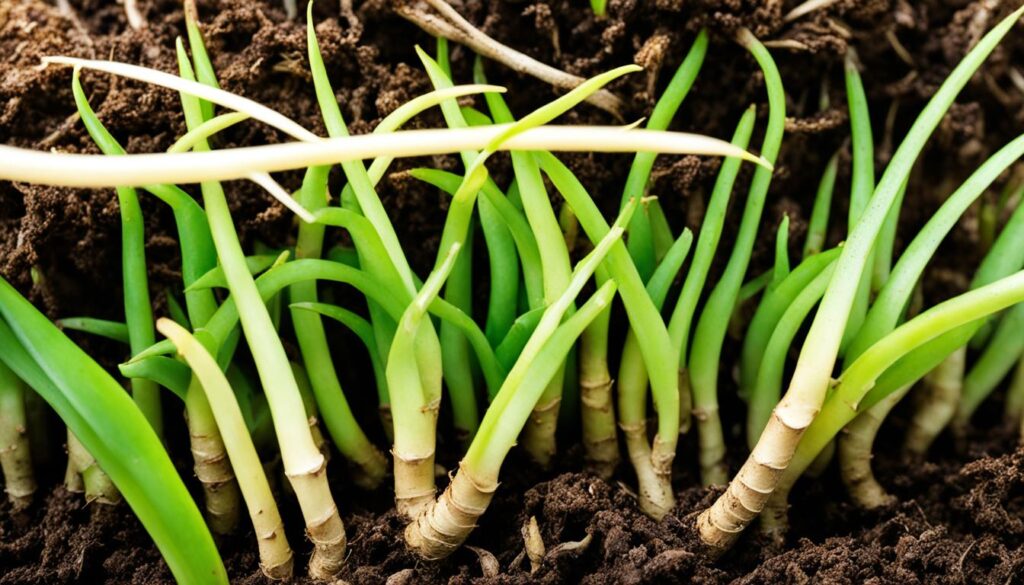
| Care Tips for Ginger Root Growth | Benefits |
|---|---|
| Provide warmth | Creates a favorable environment for ginger plants |
| Maintain humidity | Simulates the plant’s natural habitat and supports growth |
| Ensure proper moisture | Prevents drying out or waterlogging |
| Use mulch | Conserves moisture and suppresses weed growth |
Conclusion
Growing ginger successfully requires replicating its tropical natural habitat as closely as possible. Providing optimal soil conditions, the right temperature range, adequate moisture, and dappled shade is crucial. By following these best practices, gardeners can ensure the best conditions for ginger root growth and enjoy a bountiful harvest.
When it comes to planting ginger, there are two main methods: using whole rhizomes or cutting them into pieces and pre-sprouting indoors for an earlier harvest. Both approaches can be effective, but it’s important to pay careful attention to watering and drainage. Ginger cannot tolerate standing water or drying out completely, so finding the right balance is key.
Remember that ginger thrives in warm temperatures, ideally ranging from 70° to 90°F (21° to 32°C). Additionally, ginger plants appreciate some dappled shade, as it protects them from direct sunlight and helps prevent the soil from drying out too quickly. Creating these optimal conditions will give your ginger the best chance to grow and thrive.
So whether you’re growing ginger in the ground, in containers, or in a greenhouse, make sure to provide it with the right environment. By replicating its tropical natural habitat as closely as possible and paying attention to its specific needs, you can enjoy a bountiful harvest of delicious and aromatic ginger roots.
FAQ
What are the best conditions for ginger root growth?
What are the optimal soil conditions for ginger root growth?
What is the ideal temperature range for ginger root growth?
How important is moisture for ginger root growth?
What are the benefits of dappled shade for ginger root growth?
What are the recommended planting techniques for ginger root growth?
What are the care tips for ginger root growth?
- About the Author
- Latest Posts
Meet Katherine, the creative enthusiast at ByRetreat who infuses her boundless passion for design into every remote workspace she crafts. With an innate sense of creativity and an eye for unconventional beauty, Katherine brings a unique and inspiring perspective to the team.
Katherine’s love for design is infectious, and her ability to think outside the box sets her apart. She believes that true artistry lies in embracing a variety of styles and mixing them harmoniously to create captivating spaces. By combining different textures, colors, and patterns, Katherine weaves a tapestry of creativity that breathes life into each remote workspace.
-

 Vetted5 days ago
Vetted5 days ago15 Best Printers of 2024: Top Picks and Expert Reviews
-

 Vetted1 week ago
Vetted1 week ago15 Best Tile Sealers for Long-Lasting Protection and Shine
-

 Vetted2 weeks ago
Vetted2 weeks ago15 Best Smelling Floor Cleaners That Will Leave Your Home Fresh and Inviting
-

 Vetted1 week ago
Vetted1 week ago14 Best Power Scrubbers for Showers That Will Transform Your Cleaning Routine
-

 Vetted2 days ago
Vetted2 days ago15 Best Evergreen Plants for Shade Gardens: A Complete Guide
-

 Vetted2 days ago
Vetted2 days ago15 Best LED Dimmer Switches With No Flicker: Ultimate Guide for a Flicker-Free Lighting Experience
-

 Mardi Gras Decoration4 days ago
Mardi Gras Decoration4 days agoWhat Do the Symbols of Mardi Gras Mean?
-

 Appliances1 week ago
Appliances1 week ago5 Best Energy-Efficient Stainless Steel Fridges 2023









